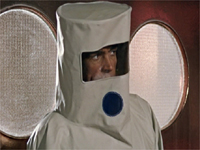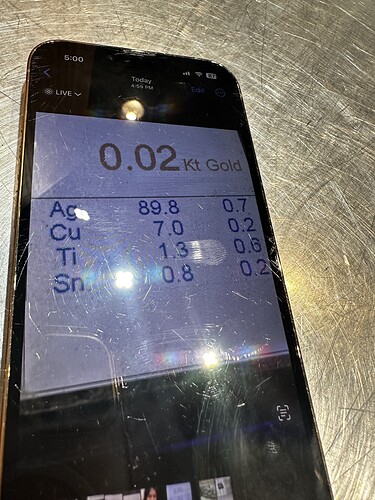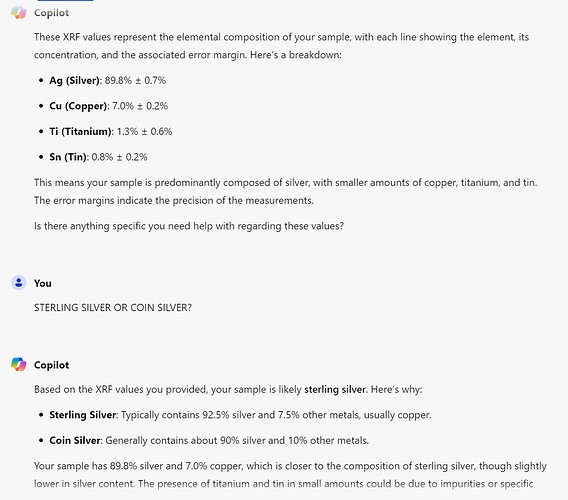Coin Silver
The alloy of silver favored for currency, though no international standard was ever adopted. Varies from as much as ninety to as little as seventy-five percent silver with the rest added copper or some other metal for hardness. There is a perception that silver made by melting coins is somehow more desirable than silver from other sources. Since sterling is ninety-two point five per cent it is pretty hard to tell one from another. Mostly used in Navajo jewelry. Except in cast pieces, Zuni silver is so minimal it hardly would matter if the collector could tell the difference.
Is there a way to tell the difference between sterling silver and coin silver without getting a chemist involved or wearing a contamination suit? 

XRF analyzer
https://www.google.com/search?client=opera&q=xrf+analyzer&sourceid=opera&ie=UTF-8&oe=UTF-8
quite pricey though
some scrap yards have them by the scale at all times for testing some of the claimed exotics that people show up with.
another likely holder would be a pawn shop or one of the gold buyers on every corner downtown
Thanks Steve. Hiring a chemist might be less expensive. 
How about higher-end Indian jewelry shops like Perry Null, Garlands, Shiprock, etc.? I wonder if they would have one? I’ll tag @Jason for his take.
there are also ebay members who will XRF test 1 item for a low of 14.99 and up plus round trip shipping expenses.
https://www.ebay.com/sch/i.html?_from=R40&_trksid=m570.l1313&_nkw=xrf+testing+service&_sacat=0
most will include the detailed analysis results printout.
these prices have come down quite a bit. just a few years ago the going rates i remember were in the 45 dollar + playground
Good information. Thank you!
But that would entail hiring Bond, James Bond.
As far as I know, Sean Connery doesn’t qualify for Turquoise Celebrities, so I thought I would sneak him in this way. 
We’ll have to scour his photos!!! I know he was in one or two westerns…
My local pawn shop tested my squash in their XRF for free.
What was sold as sterling silver is in fact coin silver.
Hi Steve,
Thank you for your response.
Interesting! If I’m understanding correctly, the piece is in fact sterling silver?
Kind Regards,
Cheryl
XRF gun results will vary between brands, operators & the area of the item that was tested as well as the error margins associated with the equipment.
like any diagnosis/result a second opinion/analyisis from another source with a different XRF might tighten up the numbers.
Looking at the materials used, all of the component materials (sheet and wire) come from a modern supply house like Thunderbird, Indian Jewelers Supply, or Rio Grande. None of these ever offered coin silver in the standardized sheet and wire from which this squash was constructed. This is likely sterling silver, not coin.
Thank you so much! Great feedback!
I’m grateful for your time and the information.
![]()
![]()
![]()
![]()
Please avoid the term coin silver when talking about fineness. Coins come in all fineness you can think of.
Examples:
below 800 (many ancient coins)
800 (Canada, …)
900 (many countries including Germany, Italy, Russia, US, …)
917 (UK, India, …)
925 sterling (Australia, Panama, Canada, Japan, …)
999 (mostly newer coins)
and all other finenesses in between also exist (991 and 873 in Japan, 640 and 835 in Austria)
Basically most coins in circulation (= as money) have been up to 925 maximum, and silver in circulation stopped in the 1960s in most countries. Few countries continued for some years, but value of silver started skyrocketing, thus investors from all around the world came to exchange new money for old silver coins, tons of coins to melt and make profit.
@gt75 You may not realize that coin silver is a legitimate, time-honored reference in Native American jewelry. It has to do with processes in the earliest phases in the US, and specific coinage used then (Mexican and US Govt.).
It is, however, almost always incorrect as a guess about jewelry in recent decades. Today it’s only in use by a few outstanding Revival silversmiths.
Thank you, very interesting.
So, sterling is standardized, that is 925.
And in the NA jewelry domain, coin silver refers to 900?
It does make sense since the US mostly used 900 silver for coins up to 1964 (Morgan, Peace, Barber, Franklin, Kennedy, …)
@gt75 Do some reading on early Navajo silver (roughly 1860s-1920s). You can find many books and articles and online resources. It’s not fixated on a number but instead is descriptive about its composition, which varied between Mexican pesos and US coinage. If you care to research what those coins were composed of it still wouldn’t be definitive as a one size-fits-all answer: coin silver was affected by what those early artists had access to and how they created their alloys.


